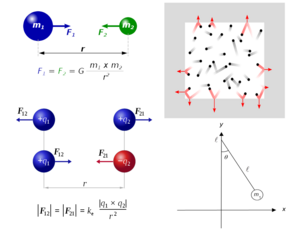
Back Puntdeeltjie Afrikaans جسيم نقطي Arabic Матэрыяльны пункт Byelorussian Матэрыяльны пункт BE-X-OLD Материална точка Bulgarian বিন্দু কণা Bengali/Bangla Partícula puntual Catalan وردیلەی نوقتەیی CKB Bodová částice Czech Йăмлăхла пăнчă CV

A point particle, ideal particle[1] or point-like particle (often spelled pointlike particle) is an idealization of particles heavily used in physics. Its defining feature is that it lacks spatial extension; being dimensionless, it does not take up space.[2] A point particle is an appropriate representation of any object whenever its size, shape, and structure are irrelevant in a given context. For example, from far enough away, any finite-size object will look and behave as a point-like object. Point masses and point charges, discussed below, are two common cases. When a point particle has an additive property, such as mass or charge, it is often represented mathematically by a Dirac delta function. In classical mechanics there is usually no concept of rotation of point particles about their "center".
In quantum mechanics, the concept of a point particle is complicated by the Heisenberg uncertainty principle, because even an elementary particle, with no internal structure, occupies a nonzero volume. For example, the atomic orbit of an electron in the hydrogen atom occupies a volume of ~10−30 m3. There is nevertheless a distinction between elementary particles such as electrons or quarks, which have no known internal structure, and composite particles such as protons and neutrons, whose internal structures are made up of quarks. Elementary particles are sometimes called "point particles" in reference to their lack of internal structure, but this is in a different sense than that discussed herein.
- ^ Ohanian, H. C.; Markert, J. T. (2007). Physics for Engineers and Scientists. Vol. 1 (3rd ed.). Norton. p. 3. ISBN 978-0-393-93003-0.
- ^ Udwadia, F. E.; Kalaba, R. E. (2007). Analytical Dynamics: A New Approach. Cambridge University Press. p. 1. ISBN 978-0-521-04833-0.